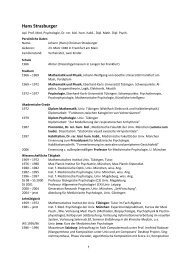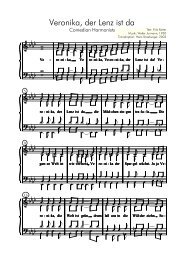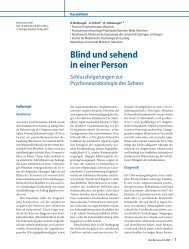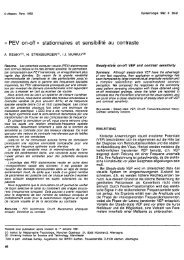Peripheral vision and pattern recognition: a review - strasburger - main
Peripheral vision and pattern recognition: a review - strasburger - main
Peripheral vision and pattern recognition: a review - strasburger - main
You also want an ePaper? Increase the reach of your titles
YUMPU automatically turns print PDFs into web optimized ePapers that Google loves.
<strong>Peripheral</strong>_Vision.doc<br />
In an even more extensive study involving twenty healthy young observers, Strasburger, Gothe,<br />
<strong>and</strong> Lutz (2001) compared contrast sensitivity for <strong>recognition</strong> to that for detection in a finelyspaced<br />
raster covering the full central field with a 20-deg-radius. Detection stimuli were Gabor<br />
<strong>pattern</strong>s (1 cyc/deg, sigma 1.5 deg; discrimination of vertical vs. horizontal orientation was<br />
taken as a measure of detection); <strong>recognition</strong> stimuli were as before the digits 0–9 at a height of<br />
2.4 deg, the contrast thresholds of which were determined at 65 positions in a polar raster.<br />
Overall, close to 100,000 observer responses were collected. Results are shown in Figure 15<br />
<strong>and</strong> Figure 16. All subjects showed stable but inter-individually somewhat different sensitivity<br />
surfaces. Contrast thresholds for detection <strong>and</strong> <strong>recognition</strong> increased in the mean linearly with<br />
eccentricity out to 30° eccentricity, by 0.029 logC/° for Gabor patch detection <strong>and</strong> by 0.036<br />
logC/° for character <strong>recognition</strong>. Recognition contrast thresholds were by 0.25 to 0.50 log units<br />
higher than those for detection. There was some variation between subjects but less than<br />
between conditions. No difference was observed between the left <strong>and</strong> right visual field. Again<br />
there was a performance plateau on the horizontal meridian between 15° <strong>and</strong> 20° (Figure 15b)<br />
(Strasburger et al., 2001, Strasburger, 2003b).<br />
Figure 14. Visual fields of <strong>recognition</strong><br />
<strong>and</strong> detection for one subject (CH).<br />
Recognition fields (heavy lines) are<br />
obtained from threshold-contrast-vs.-size<br />
trade-off functions as shown in Figure<br />
13. The form of the field is approximated<br />
by ellipses. Each ellipse shows the<br />
border of <strong>recognition</strong> at a given level of<br />
contrast, at the values 1.2%, 2%, 3%,<br />
4%, 6%, 10%, 30% starting from the<br />
inner circle (contrast in Michelson units).<br />
Note the performance plateau on the<br />
horizontal meridian between 10° <strong>and</strong> 25°<br />
(between the 3% <strong>and</strong> 4% line), similar to<br />
the one found in perimetry (Harvey &<br />
Pöppel, 1972; Pöppel & Harvey, 1973).<br />
The 100%-contrast ellipse represents a<br />
maximum field of <strong>recognition</strong> obtained<br />
by extrapolation; its diameter is 46°×32°.<br />
Also indicated in dashed lines are the<br />
fields of light-spot detection in st<strong>and</strong>ard<br />
static perimetry for the same subject.<br />
(From Strasburger & Rentschler, 1996,<br />
Fig. 4.)<br />
44






